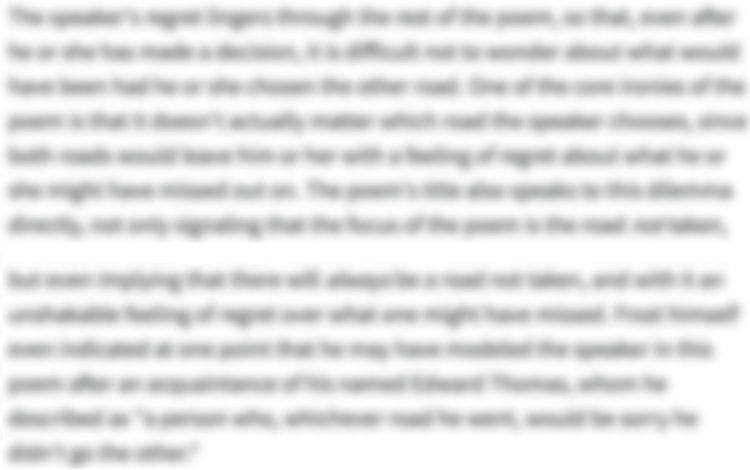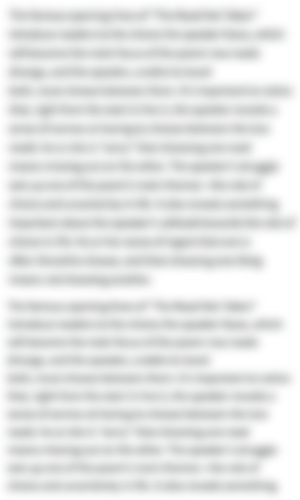The Full Text of “La Belle Dame sans Merci”
1O what can ail thee, knight-at-arms,
2 Alone and palely loitering?
3The sedge has withered from the lake,
4 And no birds sing.
5O what can ail thee, knight-at-arms,
6 So haggard and so woe-begone?
7The squirrel’s granary is full,
8 And the harvest’s done.
9I see a lily on thy brow,
10 With anguish moist and fever-dew,
11And on thy cheeks a fading rose
12 Fast withereth too.
13I met a lady in the meads,
14 Full beautiful—a faery’s child,
15Her hair was long, her foot was light,
16 And her eyes were wild.
17I made a garland for her head,
18 And bracelets too, and fragrant zone;
19She looked at me as she did love,
20 And made sweet moan.
21I set her on my pacing steed,
22 And nothing else saw all day long,
23For sidelong would she bend, and sing
24 A faery’s song.
25She found me roots of relish sweet,
26 And honey wild, and manna-dew,
27And sure in language strange she said—
28 ‘I love thee true’.
29She took me to her Elfin grot,
30 And there she wept and sighed full sore,
31And there I shut her wild wild eyes
32 With kisses four.
33And there she lullèd me asleep,
34 And there I dreamed—Ah! woe betide!—
35The latest dream I ever dreamt
36 On the cold hill side.
37I saw pale kings and princes too,
38 Pale warriors, death-pale were they all;
39They cried—'La Belle Dame sans Merci
40 Thee hath in thrall!'
41I saw their starved lips in the gloam,
42 With horrid warning gapèd wide,
43And I awoke and found me here,
44 On the cold hill’s side.
45And this is why I sojourn here,
46 Alone and palely loitering,
47Though the sedge is withered from the lake,
48 And no birds sing.
-
“La Belle Dame sans Merci” Introduction
-
“La Belle Dame sans Merci” is a ballad by John Keats, one of the most studied and highly regarded English Romantic poets. In the poem, a medieval knight recounts a fanciful romp in the countryside with a fairy woman—La Belle Dame sans Merci, which means "The Beautiful Lady Without Mercy" in French—that ends in cold horror. Related to this focus on death and horror, Keats wrote the poem months after his brother Tom died of tuberculosis.
-
-
“La Belle Dame sans Merci” Summary
-
What’s the matter, knight in shining armor, standing alone, looking rather ill? The plant life by the lakeside has shriveled up and the sound of birdsong is absent.
Again, tell me, what’s the matter? You look extremely distressed and sad. The squirrels have gathered their provisions for winter, and we humans have harvested our fields.
Your forehead is pale like a lily and moist with the sweat of a painful fever. The color in your cheeks, once bright and lively as a rose, is fading extremely quickly.
I, the knight, met a woman in the meadows. She was so enchantingly beautiful I assumed she was the child of fairy. She had long hair, she moved so gracefully she seemed to hover over the earth, and she had a mysterious wildness in her eyes.
From flowers, stems, and leaves I wove a crown for her to wear. I also wove her bracelets, and a belt strong with the scent of the flowers I used to make it. Having received my gifts, she looked at me—it was the look of someone falling in love—and she moaned sweetly.
I sat her behind me on my trotting horse, yet that whole day I saw nothing but her—as we trotted along, she would lean forward and around me, singing a mysterious fairy song.
When we stopped, she dug up sweet, nutritious roots for me. She served me wild honey, and a substance so heavenly in taste it reminded me of manna, the food that kept the Israelites alive on their journey out of Egypt. In a strange language that I nevertheless understood, she said, “I truly love you.”
Next she took me to her enchanted cave, where, overwhelmed with emotion, she wept and sighed—something pained her. I shut those wild eyes of hers by kissing her four times in an attempt to soothe her.
Next, she lulled me to sleep, and I fell into a deep dream—it still fills me with sadness and despair to remember it! That was the last dream I ever had, in that cave, which was located on a cold hillside.
In it I saw pale kings, princes, and warriors gathered around me. I saw the color of death in all of their faces. They told me that La Belle Dame sans Merci—The Beautiful Lady Without Mercy—had taken me as her prisoner.
I saw their love-starved, life-starved lips in the dying light. These lips widened as they warned me about the trouble I’d gotten myself into. Then I woke up, and found myself here, on this cold hillside.
So that's the answer to your question—that's why I linger here alone, looking rather unhealthy, even though, as you say, the plant life by the lakeside has shriveled up and the sound of birdsong is absent.
-
-
“La Belle Dame sans Merci” Themes
-
Love, Obsession, and Death
In the poem, a knight tells the story of how he becomes obsessed with, and then gets abandoned by, a spirit known as La Belle Dame sans Merci, or "The Beautiful Lady Without Mercy." Though seemingly aware she’s an illusion, the knight lingers in his memory of the Lady, and it’s implied he will do so until he dies. In this relationship, the knight’s love turns from enchantment into obsession.
Through his example, the poem expresses two linked warnings about the dangers of intense romantic love. First, obsession drains one’s emotional energy. Second, when the object of obsession disappears, the lover left behind undergoes a spiritual death, losing the ability to appreciate beauty in anything but the memory of what is lost. These warnings suggest that love, though wonderful, can quickly shift into a kind of death if it becomes obsessive.
The knight first describes falling in love with the Lady as a kind of enchantment that consumes him completely. The Lady he finds in the meadow is "Full beautiful—a faery’s child." The Lady’s perfect beauty captures the knight’s attention. By describing her as the child of a magical creature, he emphasizes that her ability to charm him is a supernatural force. Enchanted further by the mysterious wildness in her eyes, the knight begins serving the Lady and devoting all his emotional energy to her. He weaves the Lady "bracelets" and "a garland," and in reward receives her "love" and "sweet moan."
However, the line between enchantment and obsession is dangerously thin. The Lady soon becomes the knight’s single focus—seemingly his single source of life. Besides the Lady, the knight sees "nothing else … all day." This may sound like hyperbole, but the knight means it: the Lady creates a private world for herself and the knight.
Soon, the knight sees her in everything—he is obsessed. The flowers transform into suitable material for the Lady to wear. The hillside cave, a feature of the natural landscape, becomes the Lady’s "Elfin grot." As the knight’s obsession deepens, he grows to depend on the Lady even for basic nutrition. The Lady feeds the knight "roots of relish sweet, / And honey wild, and manna-dew."
The allusion to manna, the supernaturally nutritious substance provided by God to the Israelites on their journey out of Egypt, implies that the Lady is literally responsible for the knight’s survival. At this point the Lady says, "I love thee true." The knight’s response is to give himself over fully to the Lady—he follows her home, soothes her, and makes himself vulnerable before her, allowing her to lull him to sleep.
Having devoted so much emotional energy to the Lady and put himself completely under her control, the knight undergoes a spiritual death when she disappears. In his dream the knight sees the Lady’s former victims: "pale kings," "princes," and "warriors"—"death-pale were they all." In their faces he sees the man he will become: someone deathly, starved, and captivated by memories of the Lady to the point of enslavement. Like them, he will wake up "death-pale," or, as the speaker first describes him, "Alone and palely loitering"—physically alive, yet condemned to replay his memory of an obsessive love for the rest of his days. The Lady is finally revealed to be La Belle Dame sans Merci—literally, The Beautiful Lady Without Mercy.
Strangely, the Lady’s merciless behavior actually consists of the love and joy she provides; her sudden disappearance is what makes the knight’s experience so painful exactly because she was previously so kind. The shape of the Lady’s cruelty suggests that anything one falls in love with or obsesses over can cause such pain, since anything can disappear in an instant. The poem thus cautions against such intense, obsessive love, arguing that it’s ultimately not worth the agony it can cause.
- See where this theme is active in the poem.
-
Imagination vs. Reality
In "La Belle Dame sans Merci," the speaker asks a medieval knight to explain why he’s lingering in a clearly inhospitable area, where winter is setting in. The knight answers by telling a sort of fairy tale that sets up a colorful, imaginative world in opposition to the barren gray reality. By the end of the story, however, it is clear that the fairy-tale world is directly responsible for the knight’s exhausted desperation. The poem suggests that the two worlds are bound together: the imagination can shape reality so profoundly that the two become indistinguishable.
The physical descriptions of the setting ground the first stanzas in the real world. Stanzas 1 and 2 evoke a specific time of year: late autumn. Plants have "withered," birdsong is absent, and the animals are preparing for winter. This somewhat harsh imagery will deepen the contrast between reality and the imagination when the knight begins his fantastic story.
That story, in turn, blurs the lines between fantasy and reality. The Lady the knight meets is "a faery’s child" who sings a "faery’s song" as she rides with the knight on his "pacing steed." She feeds him "manna-dew," then brings him to her "Elfin" cave. The story emphasizes these fanciful aspects of the knight’s experience, but it is not entirely clear at first whether the knight is using terms like "faery’s child" and "Elfin grot" literally. At this point in the poem, they could just as well be the knight’s way of saying that the Lady was extremely, enchantingly beautiful.
Even the revelation that the Lady is a spirit being doesn’t negate that. The knight describes what he saw and how it affected him—the result is the same no matter who the Lady actually is. This is why, at the end of the poem, he says quite somberly and seriously, "And this"—"this" being his experience—"is why I sojourn here."
As he dreams in the hillside cave, the knight learns from "pale kings and princes" (the Lady’s previous lovers) that he is in the deadly grips of a spirit known as La Belle Dame sans Merci. The dream is a fantasy within the knight's story—a kind of double fantasy—but it’s also here that the knight finds the actual future reflected. That is, at the deepest moment of his imaginative experience, the knight learns the truth about what has happened to him.
By the end of the poem, the knight’s actual, lived reality becomes a fusion of the barren lakeside and the memory of his experience. The knight wakes from his dream "On the cold hill’s side" and surges back into the real world—that is, the world where the poem started. This moment raises the possibility that the knight was dreaming all along. However, given how closely bound the real and imaginative worlds have become for the knight, waking doesn’t imply an escape from the memory of the Lady.
In the last stanza, the first stanza is repeated—but now the knight is speaking. The knight acknowledges his place, “Alone and palely loitering” by the lifeless lakeside, and the poem’s final image is of a desperate man lingering in the memory of an experience that may not have even happened. Ultimately, however, it doesn’t matter whether the Lady was ever really there. Unable to take his mind off this fantastical memory but also unable to return to it, the knight ends up trapped in the place where his imagination merges with his reality.
- See where this theme is active in the poem.
-
-
Line-by-Line Explanation & Analysis of “La Belle Dame sans Merci”
-
Lines 1-4
O what can ail thee, knight-at-arms,
Alone and palely loitering?
The sedge has withered from the lake,
And no birds sing.The poem’s first stanza introduces the poem’s main problem and character, builds the setting, and establishes the form.
The poem starts on a tone of lament. In isolation, the opening "O" might just as easily look like the start of a meditation on nature's beauty, or love's glory, but quickly the word "ail" (i.e. "pains" or "afflicts") intervenes and clarifies one of the poem's main themes. This is a poem about pain, and the struggle to understand it. The "O," then, kicks off the inquiry of an empathetic observer. The archaic "thee" gives the reader an early hint about the time period of the poem's setting, one confirmed by the addressee's title in the next clause: "knight-at-arms." Most likely, this poem takes place in the Middle Ages, when one wouldn't necessarily be surprised by the sudden appearance of a knight.
The precise placement of "knight-at-arms" in the line reflects some of the poem's main themes. Knight-at-arms is the knight's formal title. It represents the honorable, chivalrous knight in shining armor. Even the hyphens, which augment the choppy rigidity of the monosyllabic words, contribute to this effect. In the sentence, "knight-at-arms" is isolated by a caesura on one side and an end-stop on the other. Visually and grammatically, the knight is separated from the rest of the action. This has two effects. One, it highlights the tension between the expected composure of an ideal knight and the wallowing of this particular knight, who is a real person with real emotions (the reader will soon learn that the knight is an emotional wreck). Two, it reflects the knight's alienation from his context. As the reader will learn, though the knight loiters by the lakeside, his mind is in a completely different place.
This alienation starts coming through in line 2, in which the knight is described as "Alone and palely loitering." Already the knight is out of context—he's not with other knights, or doing knightly things, but rather alone, seeming to do nothing at all. These words—"alone," "pale," and "loitering"—also hint at some of the poem's main themes. The knight is alone, but was once with someone he loved; he is pale, or reminiscent of death; and he loiters, literally incapable of moving on to the next thing.
The next two lines build on the theme of death, and further establish the setting. The "sedge," or grassy plant life, "has withered from the lake." By using the perfect tense in "has withered," the poem suggests that the withering, though complete, happened recently. The reader, then, might assume that the poem is somewhere between fall and winter. Along with the shriveling plant life, "no birds sing," another sign that winter is setting in. These tokens of death enhance the knight's deathly aspect, and the suggestion of seasonal change signals that the poem will deal with the concept of repeating cycles.
Finally, this jam-packed first stanza establishes the poem's meter. Like other English ballads, Keats works in quatrains, or four-line stanzas, but he adds some of his own touches. The first three lines of every stanza are in iambic tetrameter (each line has eight syllables), and the fourth line of each stanza has four to five syllables.
Stanza 1 follows the meter faithfully, as will the others. It begins,
O what | can ail | thee, knight |-at-arms?
The uniform beats of the unstressed-stressed iambs are appropriate for a ballad, a form that was originally accompanied by music and dance. In this line, the stress falls on the most important words. "What" in some ways prefigures the rest of the poem, as it forms the question the knight will answer; "ail" refers to the knight's pain; and "knight" and "arms" introduce the main character.
The meter in line 4 also serves a special purpose.
And no | birds sing.
This final line kills the rhythm of the three preceding lines. Its first stressed word is "no," giving defeated emphasis to the poem's description of death. As in the poem's other stanza-concluding lines, this one both freezes the preceding imagery with its clipped, terse sound, and, with its monosyllabic speed, propels the poem into the next stanza.
-
Lines 5-8
O what can ail thee, knight-at-arms,
So haggard and so woe-begone?
The squirrel’s granary is full,
And the harvest’s done.

Unlock all 345 words of this analysis of Lines 5-8 of “La Belle Dame sans Merci,” and get the Line-by-Line Analysis for every poem we cover.
Plus so much more...
Get LitCharts A+ -
Lines 9-12
I see a lily on thy brow,
With anguish moist and fever-dew,
And on thy cheeks a fading rose
Fast withereth too. -
Lines 13-16
I met a lady in the meads,
Full beautiful—a faery’s child,
Her hair was long, her foot was light,
And her eyes were wild. -
Lines 17-20
I made a garland for her head,
And bracelets too, and fragrant zone;
She looked at me as she did love,
And made sweet moan. -
Lines 21-24
I set her on my pacing steed,
And nothing else saw all day long,
For sidelong would she bend, and sing
A faery’s song. -
Lines 25-28
She found me roots of relish sweet,
And honey wild, and manna-dew,
And sure in language strange she said—
‘I love thee true’. -
Lines 29-32
She took me to her Elfin grot,
And there she wept and sighed full sore,
And there I shut her wild wild eyes
With kisses four. -
Lines 33-36
And there she lullèd me asleep,
And there I dreamed—Ah! woe betide!—
The latest dream I ever dreamt
On the cold hill side. -
Lines 37-40
I saw pale kings and princes too,
Pale warriors, death-pale were they all;
They cried—'La Belle Dame sans Merci
Thee hath in thrall!' -
Lines 41-44
I saw their starved lips in the gloam,
With horrid warning gapèd wide,
And I awoke and found me here,
On the cold hill’s side. -
Lines 45-48
And this is why I sojourn here,
Alone and palely loitering,
Though the sedge is withered from the lake,
And no birds sing.
-
-
“La Belle Dame sans Merci” Symbols
-
Flowers
In stanza 3, the speaker observes that the knight’s brow is pale like a “lily,” and that the color in his cheeks is draining quickly, like “a fading rose.” In poetry from this time period (the early 19th century), the lily symbolized death, while the rose symbolized love and beauty. In this particular poem, the lily and the rose, beautiful on the surface, symbolize the inherent danger in beauty, which can be so delicate that it withers in an instant, leaving its admirers lost and disillusioned.
In stanza 3 the speaker compares the knight’s brow to a lily, some types of which are white. On one hand, this comparison to a pale lily suggests the trace of death in the knight's face. On the other hand, a white lily is a live, healthy lily. In connection with the knight, this seems to imply that he still has some life left in him. The red rose supports this reading. Yes, the rose withers quickly, but it’s not dead yet. Only after it does die will the knight’s cheek be white like his brow, like the lily. Here, the poem identifies the beauty of a kind of life-in-death, while also demonstrating how “fast” beauty can fade to death.
This understanding of the flowers influences the other plant life that appears in the poem. In stanza 5, the knight uses flowers to a weave a garland and bracelets for the Lady. At the peak of their vitality and fragrance, these flowers are used to accentuate the Lady’s beauty. In retrospect, after the Lady has been revealed for what she is, this beauty will appear evil. In stanza 7, the Lady feeds the knight “honey wild” and “manna-dew.” In the moment, this plant life appears nutritious and invigorating, though the knight’s fate suggests that it acts more like a poison. The reader will notice that “manna-dew” echoes “fever-dew” from stanza 3, the cold sweat that appears on the knight’s brow like morning dew on the lily petals. Here, the poem identifies the manna-dew as one cause of the knight’s deathly, feverish state. Again, plant life paradoxically embodies both life and death.
- See where this symbol appears in the poem.
-
-
“La Belle Dame sans Merci” Poetic Devices & Figurative Language
-
Dialogue
The entire poem can be thought of as a dialogue. It begins with an anonymous speaker. That speaker addresses the knight and asks him a question (stanzas 1-3). The knight answers, and speaks for the rest of the poem (4-12). The poem ends with knight restating his answer to the speaker's question. Though this dialogue is limited (the knight doesn’t give the speaker a chance to ask follow-up questions), it complicates the poem by giving it two perspectives.
Dialogue is one of the main tools that fiction writers use to deepen and enrich their characters. It works similarly in this poem. In the case of the knight, it gives him the space to explain himself. As for the speaker who questions the knight, by engaging in a dialogue this speaker comes across as curious, empathetic, observant, and perhaps slightly worried. With the repeated question (“O what can ail thee”), the speaker expresses his or her desire to understand what afflicts the knight. With comments on the knight’s appearance (he is alone, pale, and anguished), the speaker empathizes with the knight, perhaps conveying a similar state of despair.
The dialogue also serves a technical purpose by providing context and depicting the appearance of the knight. In other words, the first speaker’s presence adds a concrete quality to this world. Without the speaker, there would be no way to contextualize the knight in the world around him. It wouldn’t be very believable if the knight, whose mind revolves around the memory of the Lady, described the autumnal present with the same specificity as the speaker, nor would it be elegant if he introduced himself, saying, “Hello, I am a knight-at-arms. I am lovesick and slowly dying.” Instead, the speaker describes the bleakness of the "real" world, while the knight focuses on his own fantastical memories.
- See where this poetic device appears in the poem.
-
Anaphora


Unlock all 452 words of this analysis of Anaphora in “La Belle Dame sans Merci,” and get the poetic device analyses for every poem we cover.
Plus so much more...
Get LitCharts A+ -
Metaphor
-
Alliteration
-
End-Stopped Line
-
Caesura
-
Allusion
-
Epizeuxis
-
Refrain
-
Diacope
-
Enjambment
-
Consonance
-
Polyptoton
-
-
“La Belle Dame sans Merci” Vocabulary
Select any word below to get its definition in the context of the poem. The words are listed in the order in which they appear in the poem.
- Ail
- Knight-at-arms
- Sedge
- Haggard
- Woe-begone
- Granary
- Fever-dew
- Withereth
- Meads
- Fragrant Zone
- Steed
- Manna-dew
- Grot
- Woe Betide
- Latest
- La Belle Dame sans Merci
- Thrall
- Gloam
- Gapèd
- Sojourn
Ail-
Ail is a verb that means "to trouble, pain, or afflict." Its noun form, ailment, usually refers to an injury or illness. In the poem, the knight suffers from an emotional ailment, though it certainly seems to have physical ramifications. Ail comes from the Old English word egle, which means "troublesome." The knight’s pain is troublesome in that it lingers and won’t leave him alone.
- See where this vocabulary word appears in the poem.
-
Form, Meter, & Rhyme Scheme of “La Belle Dame sans Merci”
-
Form
“La Belle Dame sans Merci” is a ballad, a longer, typically narrative poem derived from the French form chanson balladée, a type of rhyming verse that was set to music for dancing. The poem involves a dialogue between the speaker and the knight, a sort of call-and-response appropriate given the form’s dance-hall origins. The poem’s content also nods towards the context that produced the form—ballads were first popular in the later medieval period, right around the time the sight of a “knight-at-arms” on a “pacing steed” would have been commonplace.
The poem is divided into 12 quatrains, or four-line stanzas. A strong meter (iambic pentameter), one that might pair well with music, drives it forward. The first three lines of each stanza are in this meter, while each stanza's ending line is shortened to two feet of four to five syllables (and some deviation from pure iambic). This creates a start-and-stop rhythm to the stanzas (further discussed in the meter section of this guide) that relates to the poem's interest in the tensions between life and death.
-
Meter
The poem is written in iambic tetrameter in the first three lines of every quatrain, or four-line stanza. The final line of every stanza, however, has only 4 or 5 syllables. Those with 4 syllables can be described as following iambic dimeter, though sometimes they downplay their stressed syllables. A likely model for this ballad, “The Rime of the Ancient Mariner” by Samuel Taylor Coleridge, was written in alternating iambic tetrameter and trimeter—lines with 8 syllables followed by lines with 6. Keats’s choice to fit three lines of each quatrain into tetrameter and the final line into something a bit more speedy is an example of him making something new out of an old form.
To understand the meter of this poem, it’s worth looking at examples of how Keats follows the rules, breaks them, and includes lines in which the meter is debatable.
The first stanza provides a few examples. In line 1, the poem follows its meter.
O what | can ail | thee, knight- | -at-arms,
This line is iambic through and through. As a result, the line’s keywords are emphasized: “what” invokes the poem’s central question, “ail” depicts the knight’s emotional state, “knight” introduces the poem’s main character, and “arms” solidifies the image of that character—a knight in shining armor, the type that might appear in a fairy tale. This meter also establishes the trotting rhythm that will carry this rather fast-moving poem from beginning to end. That rhythm is most evident in a line like line 21, since it mimics the horse’s pacing motion:
I set | her on | my pac | ing steed
In the second line, the meter depends on how it’s read.
Alone | and pale- | ly loi- | tering.
Specifically, the three-syllable word “loitering” can almost be read as having only two. As two syllables, the word is a trochee, a metrical foot that contains a stressed-unstressed syllable pair. The last two syllables of "loitering" might also be read as unstressed (i.e. "loi- | tering"), in which case the ending foot would be a pyrrhic. In any case, even if the final syllable is stressed, the stress is light.
A similar case is line 38:
Pale war- | riors, death- | pale were | they all.
“Warriors” is the keyword here, because it can be read as containing either two or three syllables (i.e. "war - riors" or "war - ri - ors"). With three syllables, this line becomes one of the poem’s longest. It’s a fitting moment, as the knight elongates the horror of his dream. This line also starts with a spondee, a foot with two stressed syllables, and as a result the knight's description sounds like a frightful shout.
The poem’s only other long line is its second to last.
Though the sedge | is with- | ered from | the lake,
Because the knight has added “Though” to the speaker’s opening observation, this line now has 9 syllables. Again, this elongation is fitting: it emphasizes the knight’s loitering.
The poem also occasionally rearranges stress for emphasis, particularly during the nightmare scene, in lines 37 and 41. Here, stressed syllables bunch up to emphasize how the nightmare seems to slow down time and disturb the knight:
I saw | pale kings | and prin- | ces too
And again:
I saw | their starved | lips in | the gloam
In each case, the poem's characteristically smooth meter gets bent out of shape to reflect the knight's inner turmoil.
The lines that end the stanzas see some variation, but all are either 4 or 5 syllables. Take the end of stanza 1.
And no | birds sing.
This could be read as an example of iambic dimeter, though the poem’s somber tone might deemphasize the stressed syllables. For the most part, these stanza-ending lines contain words with just one syllable. In lines like 20 and 28 , “And made sweet moan,” and, “I love thee true,” these monosyllables accelerate the poem, moving the knight closer to his doom.In the other lines with 5 syllables, the image persists a bit longer. In line 16, “And her eyes were wild,” for example, emphasizes the sense of enchantment. In line 36, “On the cold hill side” emphasizes the fact that the knight is trapped in a limbo between love and death.
-
Rhyme Scheme
The poem follows a rhyme scheme that’s typical of ballads written in English. Each quatrain (four-line stanza) of the poem rhymes like this:
ABCB
Only the even-numbered lines rhyme, and these rhymes are nearly perfect. In this way, the poem honors not only the structure of the ballad, but also its traditional purpose, which was to accompany a song and dance—clear rhymes would have contributed to a clearly structured rhythm. The one moment of slant rhyme is in stanza 2, between “begone” in line 6 and “done” in line 8. An English speaker from the United States, however, might notice more of a difference than Keats would have, due to differences in accent.
The poem also contains a few cases of internal rhyme. For example, in the first stanza, “ail thee” in line 1 rhymes with “palely” in line 2. In stanza 4, “faery’s” in line 14 rhymes internally—and as a slant rhyme, since it isn’t perfect—with “her eyes” in line 16. These are subtle cases. The rhymed words draw attention to certain feelings in the lines without drawing attention to themselves. Take stanza 1: “ail thee” and “palely” sound like slowly drawn-out cries (or wails, to keep the rhyme going), a proper imitation of the knight’s emotional state. And in the stanza 4, the connection between "faery's" and "her eyes" emphasizes how the Lady's physical body has enchanted the knight.
-
-
“La Belle Dame sans Merci” Speaker
-
The poem has two speakers. The first is the anonymous, genderless, and generally unidentified voice that opens the poem and continues through stanza 3. The second is the knight, who speaks through the rest of the poem. The two speakers engage in a dialogue. The first speaker asks a question in line 1—"O what can ail thee”—and the knight responds with his tale of La Belle Dame sans Merci.
Since the poem shows the knight loitering by a barren lakeside in the country, the reader might imagine the speaker as a traveler, someone passing through the area who comes across the knight unexpectedly (a dim reflection of the way the knight “met a lady in the meads” in line 13). This speaker is characterized by his or her concern for the knight. The knight is obviously distraught, and the speaker is curious to know why.
After stanza 3, the first speaker becomes a listener and hands things over to the knight. The knight is a medieval warrior, equipped with armor and a horse. On a trip through the countryside (the area seems unpopulated, and it’s not clear what the knight is doing there), he comes across a beautiful lady. In his telling of the story, the knight is passionate, lustful, obsessed, and drunkenly in love. The lady’s beauty is absolute (she's described as “Full beautiful” in line 14), and the knight devotes himself to her. He weaves her garlands, treats her to a ride on his horse, and in lines 31-32 “shut[s] her wild wild eyes / With kisses four” when she brings him to her cave and weeps. When the lady vanishes, the result of the knight’s passion is a spiritual death. He pours his heart into the lady, and now she’s gone. “And this is why,” the knight somberly explains in line 45, he lingers by the lake, a shell of his once-vigorous self.
-
-
“La Belle Dame sans Merci” Setting
-
The poem takes place in the countryside during the Middle Ages, a period in Europe that lasted between the 5th and 15th centuries. The time period can be specified somewhat if the reader considers the knight’s chivalric treatment of the lady: the informal chivalric code was developed after the 11th century. The country can be described as generically European, though Keats’s England or the France of Alain Chartier, the poet whose 15th-century poem this one is based on, are good guesses.
The season is late autumn. Plant life has “withered” from the lake in line 3, and in line 8 “the harvest’s done”—everyone and everything is preparing for winter. The specific place is the zone between a lake and “the cold hill side” of line 36, where the knight wakes from his dream. In the knight’s story, he and the lady ride his horse through the surrounding area. They meet in a meadow, dig up roots from the soil, and embrace in a cave.
The knight’s dream can also be considered part of the setting. It’s a place populated by the “pale kings and princes” of line 37, and reflected in the cold hill side and withered lakeshore.
-
-
Literary and Historical Context of “La Belle Dame sans Merci”
Literary Context
Lyrical Ballads, a collaborative book written by poets William Wordsworth and Samuel Taylor Coleridge, shifted the English Romantic movement into high gear. It was published in 1798. At that point, John Keats was just a toddler. In his 20s (he wouldn’t live past 25) Keats would meet both Wordsworth and Coleridge. He admired them, but was critical as well. He was particularly wary of Wordsworth’s egotism; he aspired in his own work to create a poetry that sought truth in the imagination without getting muddled by any rigid belief systems. (In an 1817 letter to his brothers Tom and George, Keats introduced a concept called “negative capability,” which refers to the poet’s ability to follow inspiration without letting prejudice get in the way—basically, to take an idea and run with it.) That said, Coleridge's poem, “The Rime of the Ancient Mariner,” was one of the major influences on Keats's “La Belle Dame sans Merci.”
The poets Lord Byron and Percy Bysshe Shelley were just a few years older than Keats. They recognized his talent and encouraged his work, though they also contributed to some misconceptions about the young poet’s life. After Keats died of tuberculosis in 1821, Shelley wrote a long poem called Adonais that blamed "wretched" critics, including "a most base and unprincipled calumniator," for Keats’s physical breakdown. In his book length poem Don Juan, Byron perpetuates the same idea, alluding to Keats with the lines, “Tis strange the mind, that very fiery particle, / Should let itself be snuffed out by an Article.” Keats did receive more than his fair share of ruthless criticism in his lifetime, but he responded to it with more poise than his contemporaries gave him credit for. What killed him was tuberculosis, which at the time didn’t have a specific treatment because it hadn’t been identified as a disease with a specific cause.
“La Belle Dame sans Merci” was written in April 1819. It draws on a 15th century poem by the French poet Alain Chartrier, which tells a similar story and can be read here in an English translation. Additionally, Keats draws on flower imagery that was frequently used in English literature during and before the Romantic period. The rose and lily often appeared together, as in William Cowper’s 1782 poem “The Lily and the Rose,” in which the flowers vie for England’s admiration.
Keats's poem was published in May 1820 in the journal Indicator, which was edited by Leigh Hunt, an influential progressive writer and publisher who was a friend of and early influence on Keats. This year, just two before his death, was the most productive of Keats’s literary career. After writing this poem, he would go on to compose his odes (for example, “To Autumn,” “Ode to a Nightingale,” and “Ode on a Grecian Urn”), which are considered among the most famous poems in the English language. By 1848, when the first biography of Keats was published, Keats’s prominent place in the English canon was solidified.
Historical Context
“La Belle Dame sans Merci” was written in 1819—surely an interesting time to be alive. Four years earlier, Napoleon’s army had fallen at the Battle of Waterloo, and England, having financed much of the dictator’s opposition, was enjoying at least some of the spoils. George, Prince of Wales ruled England as a proxy for his father, King George III, whose mental illness crippled his ability to lead, and who would be ridiculed by Percy Shelley as “old, mad, blind, despised, and dying” in his sonnet “England in 1819” (which actually wouldn’t be published till 1839). In the British cities, industrialization raised factories and forged a working class that would increasingly agitate for reforms to factory conditions and their political rights. Queen Victoria was born this year, on May 24; the society that flourished during her rule would elevate Keats’s work to the high place it holds today in the English canon.
In Keats’s personal history, this was a time of love and loss. In December 1818, his brother Tom had died of tuberculosis. Keats, trained as a surgeon, had acted as Tom’s nurse. Keats would die of the same disease two years later, and some biographers suggest that he first became infected while nursing his brother. The spring of 1819 was also the peak of Keats’s fiery, though perhaps unconsummated, relationship with Fanny Brawne, the neighbor and eventual fiancée (though they would never marry) to whom he dedicated his sonnet, “Bright star, would I were stedfast as thou art.” Their relationship was the inspiration for the 2009 John Keats biopic Bright Star.
-
More “La Belle Dame sans Merci” Resources
-
External Resources
-
John Keats Biography — An in-depth biography that tracks Keats’s career, personal relationships, and the evolution of his poetical thinking.
-
Keats's Letter about Negative Capability — The 1817 letter from Keats to his brothers, George and Thomas, in which he describes his famous poetic concept of "negative capability."
-
Keats's Letter About the "Mansion of Many Apartments" — A short analysis of another famous concept expressed in Keats’s letters, the “Mansion of Many Apartments.”
-
Actor Ben Whishaw Reads "La Belle Dame sans Merci" — Ben Whishaw, who played John Keats in the 2009 biopic Bright Star, reads the poem.
-
A Painting of "La Belle Dame sans Merci" — Artist John William Waterhouse's interpretation of Keats's poem, painted in 1893.
-
-
LitCharts on Other Poems by John Keats
-











